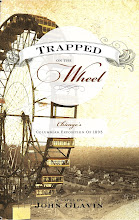
How did Ferris get his idea for the giant wheel for the Chicago Exposition of 1893? Listen to his own words:
"It was at one of these dinners, down in a Chicago Chop House, that I hit on the idea. I remember remarking that I would build a wheel, a monster. I got some paper, and began to sketch it out. I fixed the size, determined the construction, the number of cars we would run, the number of people it would hold, what we would charge, the plan of stopping six times in the complete turn - in short, before the dinner was over I had sketched out almost the entire detail, and my plan has never varied an item from that day."
Ferris had a reputation of playing the press, so keep that in mind.
Personally I prefer the childhood account of young George by Katherine Gehms (Copley News Service).
"The rickety wooden structure, which spanned the stream, provided easy crossing for covered wagon traffic to California vs the Overland Trail. As an added convenience a revolving wheel close to the cradlebaugh bridge hoistered water for thirsty stock.
"Although Gale (in his youth, he may have been called by one of his middle names to avoid confusion since his father's name also was George) became interested in the construction of this haphazardly built overpass, the workings of the water wheel intrigued him even more. So, instead of helping on the ranch with the growing of hay, grain and vegetables as all youngsters were expected to do, the Ferris boy spent most of his time studying the water wheel down by the bridge.
"Of course, during this time, Gale's parents kept after him constantly to help more in the fields. Yet every day held spend hour after hour lying on the river bank all but hypnotized by the motion of the big wheel lifting water to the stock troughs.
"Finally, by the time Gale became a teenager, his parents were exasperated with his apparent idleness. They sent him to a California Military Academy to learn some discipline."
So, dear blogger, which do you prefer - the press release or the childhood vision?








